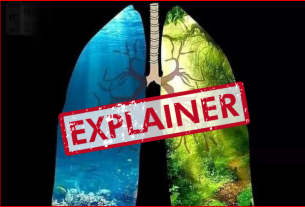Fact Checked by G. Rashmitha Diwyanjalee
A viral video claims that Canada is already below the net zero level of carbon tax. The person in the video mentions that Canada has 320 billion trees and needs only 30 billion trees to absorb all the carbon emitted in a year. However, some sources state that Canada aims to achieve net zero carbon emissions by 2050. Therefore, we decided to fact-check this claim.
What is the purpose of Carbon Tax?
The carbon tax is a financial charge imposed on the carbon content of fossil fuels, aimed at reducing carbon dioxide (CO₂) emissions and combating climate change.
The purpose of a carbon tax is to address the urgent need for decarburization in response to climate change, which is recognized as one of the most critical issues facing humanity. The primary aim of a carbon tax is to put a direct and accurate price on carbon emissions resulting from the burning of fossil fuels. This pricing mechanism is designed to incorporate the costs of pollution and climate damage into market prices, thus incentivizing reduced emissions and the adoption of clean energy alternatives across various economic sectors.
Examples of successful carbon tax implementations around the world highlight its purpose and effectiveness. For instance:
- Finland, Sweden, and Norway adopted carbon taxes in the 1990s, using the revenues to support national sustainability programs.
- Canada’s carbon pricing system under the Greenhouse Gas Pollution Pricing Act charges an economy-wide tax, with all revenues returning to provinces and residents through rebates.
- Singapore’s carbon tax, enacted in 2019, plays a crucial role in funding industry decarburization incentives
Carbon neutral and carbon negative
Carbon neutral means that carbon emissions are balanced out by carbon offsetting actions elsewhere. This involves reducing greenhouse gas emissions to the extent they are emitted, resulting in a net-zero carbon footprints. Companies, individuals, governments, and products and services can all achieve carbon neutrality through various means.
Carbon negative, on the other hand, means that more carbon dioxide (CO2) is saved or stored than emitted by a country, company, or individual. This approach actively reduces atmospheric CO2 levels, going beyond neutrality to contribute to the removal and sequestration of carbon dioxide from the atmosphere. Read more here.
Net Zero Goals:
Canada’s commitment to achieving net zero carbon emissions by 2050 is part of its climate policy, aiming to balance emissions with carbon removal through various means, including forests and other natural sinks.
Claim 1: Canada produces 708 millions of Kg of CO2 in a year
Fact
According to the Government of Canada, Canada’s total greenhouse gas (GHG) emissions were 708 megatonnes of carbon dioxide equivalent (Mt CO2 eq).
- 1 megatonne (Mt) = 1 million tonnes (1,000,000 tonnes)
- 1 tonne = 1,000 kilograms (kg)
Therefore,
- 708 megatonnes (Mt) = 708,000,000 tonnes
- 708,000,000 tonnes = 708,000,000,000 kilograms (kg)
So, Canada produces 708 billion kilograms (kg) of CO2 equivalent in a year, not 708 million kilograms.
However, between 1990 and 2022, Canada’s GHG emissions increased by 16.5% (100 Mt CO2 eq), excluding emissions and removals from the land use, land use change, and forestry sector. This overall increase was driven mainly by the oil and gas, agriculture, and transport sectors, while the electricity and heavy industry sectors saw reductions. Between 2005 and 2022, emissions decreased by 7.1% due to these reductions and the effects of the pandemic, which caused significant drops in trade and travel, especially a 16% decrease in the transport sector between 2019 and 2020. Emissions rebounded slightly in 2021 and 2022 but remained below pre-pandemic levels. The 54 Mt CO2 eq reduction from 2005 to 2022 is comparable to removing 16.5 million gas-powered vehicles from the roads for a year or the emissions from 12.6 million homes for a year.
Pic courtesy: Environment and Climate Change Canada (2024)
Claim 2: A mature tree absorbs 22 Kg of CO2 per year.
Facts
When we Google, “How Much Co2 Does A Tree Absorb?”, Many of the articles simply cite 48 pounds of carbon dioxide, However, a Forestry Specialist at One Tree Planted, says this is a confusion with the information in an article published by the European Environment Agency which suggests “Over one year a mature tree will take up about 22 kilograms [or 48 pounds] of carbon dioxide from the atmosphere, and in exchange release oxygen.” But even this article does not cite any tree-based carbon studies.
According to the Winrock International Forest Landscape Restoration (FLR) Carbon Storage Calculator, various FLR activities (including natural regeneration, planted forests and woodlots, agroforestry, and mangrove restoration) demonstrate distinct biomass accumulation rates worldwide, contributing to global CO2 removal efforts.
Pic courtesy: One Tree Planted
However, at an average planting density rate of 1,000 trees per hectare, an average tree absorbs 10 kg (or 22 pounds) of carbon dioxide per year for the first 20 years. Therefore, younger trees in the initial 20 years absorb this amount, but it doesn’t explicitly state that mature trees, beyond this age, continue to absorb CO2 at the same rate.
According to the Yale Environment Review, the overall context of forest carbon sequestration involves various factors such as tree age, size, and forest management practices that influence CO2 absorption rates. Mature trees typically absorb more CO2 as they grow larger, but the rate of absorption can vary widely based on species, health, and environmental conditions.
Furthermore, Compared to large over story trees, small trees accumulate carbon much more slowly and have higher mortality rates, yet they compete with larger trees for resources. In seasonally dry forests, fire reduces the density of small trees, promoting the growth of large, long-lived trees that store more carbon. Fire suppression in these forests encourages the establishment and survival of small trees, temporarily increasing carbon stores beyond those of frequently burned forests.
Moreover, natural cycles of low-intensity fires in dry forests can, over the long term, promote forest carbon storage by protecting carbon in soil and in large, old trees. The conundrum is how to balance immediate, disturbance-driven carbon loss with long-term, stable carbon storage and account for these risks in policies for forest carbon management.
Claim 3: So, Canada needs 30 billion of tress to achieve net zero level?
Facts
Tree planting is a significant strategy for carbon sequestration, achieving net-zero emissions involves a multifaceted approach that includes reducing emissions from various sectors, enhancing carbon sinks, and possibly using technological solutions.
However, to calculate how many trees Canada might need, we can make an estimation based on current data and average carbon sequestration rates. Let’s break this down:
- Canada’s GHG Emissions:
- In 2022, Canada’s GHG emissions were 708 Mt CO2 eq.
- A mature tree absorbs around 10 kg of CO2 per year (as per the Facts in Claim 2).
- 1 Mt CO2 = 1,000,000,000 kg CO2
Therefore, 70.8 billion trees would be needed to sequester Canada’s annual emissions of 708 Mt CO2 eq, assuming each tree absorbs 10 kg of CO2 annually. This number is far from the 30 billion trees mentioned in the claim.
Moreover, achieving net-zero emissions involves more than just planting trees. It requires:
- Reducing emissions from sectors like transportation, industry, and energy.
- Improving energy efficiency and increasing the use of renewable energy.
- Implementing sustainable agricultural and forestry practices.
- Developing and deploying carbon capture and storage technologies.
Trees play a crucial role, but they are part of a broader strategy to combat climate change. The exact number of trees needed can vary based on tree species, growth rates, forest management practices, and other factors influencing carbon sequestration capacity.
Claim 4: Canada already has 320 billion of trees
Facts
Council of Canadian Forest Ministers, say Canada’s forests cover 347 million hectares, representing nearly 9% of the world’s total forest area. Canada is the third-most forested country in the world by area, with nearly 10 hectares of forest per person, far above the global average. About 30 million hectares of Canada’s forests are in protected areas.
The global average number of trees per hectare varies significantly depending on the forest type, age, and region. A rough global average is approximately 500 trees per hectare.
Pic courtesy: Council of Canadian Forest Ministers
Tree density can vary widely depending on the forest type. For example, boreal forests, which make up a significant portion of Canada’s forest area, tend to have lower tree densities compared to tropical forests.
Canada’s Forest Management:
According to the Carbon Budget Model of the Canadian Forest Sector (CBM-CFS3), Canada’s forests are managed for sustainability, balancing ecological, economic, and social values. This management includes practices such as harvesting, replanting, and protecting forests from natural disturbances like wildfires and insect outbreaks.
Canada’s forests play a crucial role in the global carbon cycle, storing vast amounts of carbon in biomass, dead organic matter, and soils. They act as both carbon sinks and sources, depending on various factors like growth rates, disturbances, and management practices.
While the exact number of trees in Canada is challenging to pinpoint, the estimate of 320 billion trees appears to be significantly overstated based on available information. A more reasonable estimate would be around 173.5 billion trees, considering average global tree densities and the total forest area of Canada.
Theoretically, Canada’s extensive forest coverage should enable significant absorption of greenhouse gases. However, according to Canadian government websites, the reality is that Canada’s managed forests have turned into carbon sources, emitting more carbon into the atmosphere than they absorb. Consequently, these forests are not as supportive of net-zero targets as expected.Details can be read here
Various factors have driven this change, including:
- A significant rise in the yearly total area affected by wildland fires
- Unprecedented insect infestations
- Changes in annual harvest rates due to economic demand
- Forest management actions addressing the mountain pine beetle epidemic in western Canada
Net-zero emissions by 2050
According to the Government of Canada website, Canada is committed to achieving net-zero emissions by 2050. The Canadian Net-Zero Emissions Accountability Act, which became law in June 2021, enshrines this commitment in legislation. The Act ensures transparency and accountability as the government strives to meet its targets, requiring public participation and independent advice to guide its efforts.
Therefore, the viral video’s claim that Canada is already below the net-zero level of carbon emissions due to its vast forest cover is misleading. While Canada has an impressive forest area with a significant number of trees, this alone is not sufficient to offset the country’s annual carbon emissions. The actual absorption rate of CO2 by trees, the complexities of forest management, and the multifaceted approach required to achieve net-zero emissions by 2050 are often misunderstood. Canada’s commitment to net-zero emissions by 2050 involves a comprehensive strategy that includes reducing emissions across various sectors, enhancing carbon sinks, and leveraging technological solutions. Therefore, while trees play a crucial role in carbon sequestration, they are just one part of a broader strategy needed to combat climate change effectively.
Follow us and stay up to date with our latest fact checks.
Facebook | Twitter | Instagram | Google News | TikTok

Title:Is Canada already below the net-zero level of carbon emissions due to its vast forest cover?
Fact Check By: Rashmitha DiwanjaleeResult: Insight






